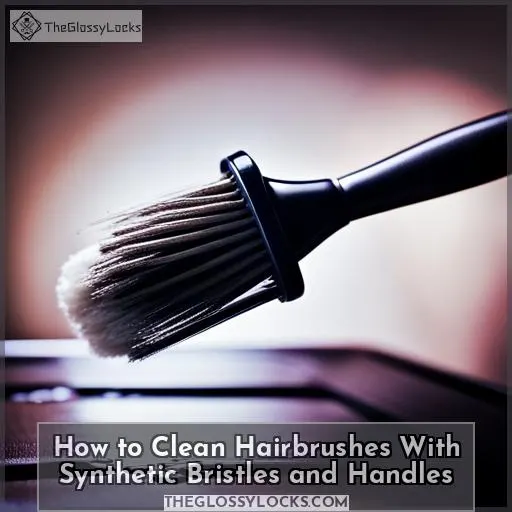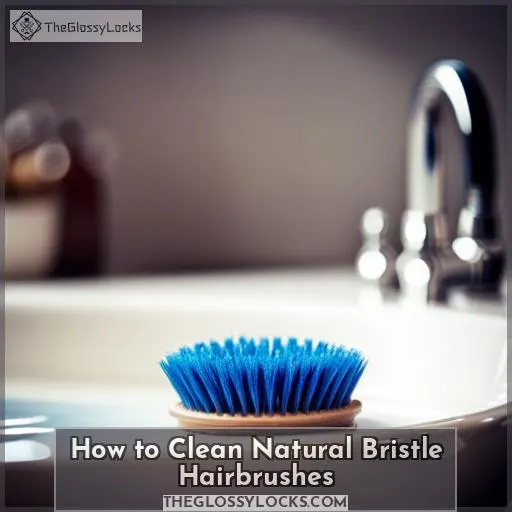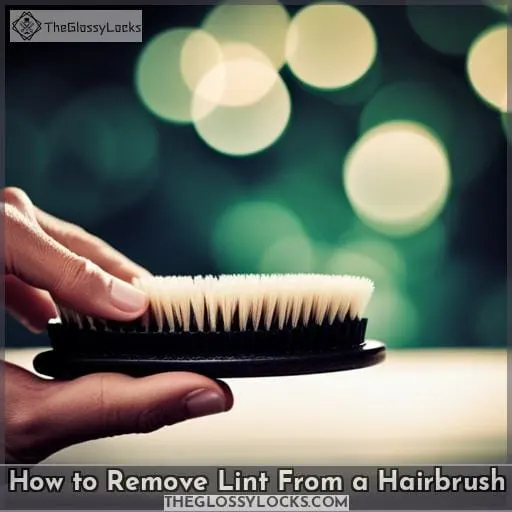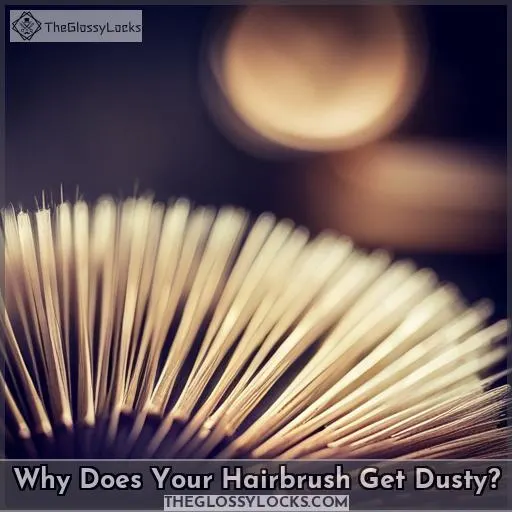This site is supported by our readers. We may earn a commission, at no cost to you, if you purchase through links.
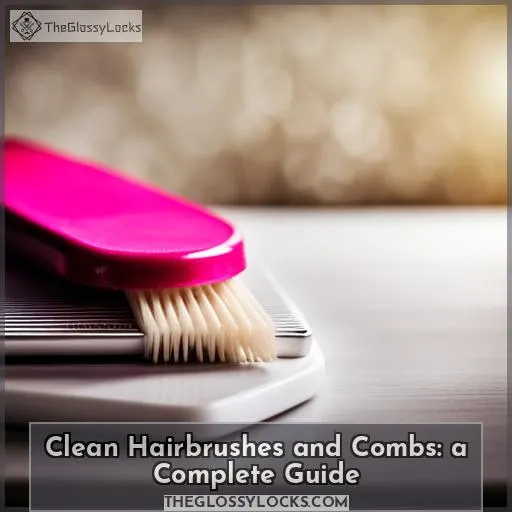 Ready to take control of your haircare routine? Learn how to clean hairbrushes and combs effectively with our complete guide.
Ready to take control of your haircare routine? Learn how to clean hairbrushes and combs effectively with our complete guide.
Say goodbye to dirty brushes and hello to a healthier scalp and luscious locks. Discover the best techniques for cleaning:
- Synthetic bristles
- Natural bristle brushes
- Wooden handles
- Synthetic combs
- And even removing lint from your tools.
Don’t let bacteria or buildup ruin your hair game – follow our expert tips for maintaining clean and hygienic hairbrushes and combs today!
Table Of Contents
- Key Takeaways
- How Often to Clean a Hairbrush or Comb
- How to Clean Hairbrushes With Synthetic Bristles and Handles
- How to Clean Natural Bristle Hairbrushes
- How to Clean a Synthetic Comb
- How to Clean a Wooden Comb
- How to Remove Lint From a Hairbrush
- Why Does Your Hairbrush Get Dusty?
- Why is It Important to Clean Your Hairbrush?
- How to Clean Different Hairbrushes and Combs?
- How to Clean Lice Comb?
- Frequently Asked Questions (FAQs)
- Conclusion
Key Takeaways
- Clean your hairbrush or comb regularly to maintain cleanliness and prevent buildup.
- Use appropriate cleaning methods based on the type of bristles and handle material.
- Remove lint and dust from your hairbrush regularly to keep it clean and functional.
- Cleaning a lice comb requires specific steps to ensure thorough disinfection and prevent reinfestation.
How Often to Clean a Hairbrush or Comb
Clean your hairbrush or comb regularly to maintain hygiene and ensure optimal performance.
How often you should clean your hairbrush or comb depends on various factors, such as:
- How frequently you use it
- The amount of product buildup you notice
For most people, a weekly cleaning is sufficient to keep their brushes and combs in good condition.
However, if you use heavy products like petroleum-based styling gels or oils, it may be necessary to clean them more frequently – perhaps every other week or even daily.
If you notice visible buildup on your brush or comb, that’s a clear sign that it needs cleaning sooner rather than later. In this case, aim for at least a bi-weekly cleaning schedule to prevent excessive residue from accumulating.
Remember that regular maintenance after each use is also crucial for keeping brushes and combs clean between deeper cleanses. By removing any trapped hairs immediately after styling sessions with these tools can help minimize dirt accumulation over time.
Overall, finding the right balance between cleanliness and convenience will depend on individual factors such as personal preferences regarding hygiene levels and usage habits.
How to Clean Hairbrushes With Synthetic Bristles and Handles
To clean hairbrushes with synthetic bristles and handles, start by removing any excess hair from the brush.
Then, fill a sink or basin with warm water and add a few drops of mild shampoo or dish soap.
Swirl the brush around in the soapy water for about 30 seconds to loosen dirt and oils.
Rinse thoroughly under running water, making sure to remove all traces of soap.
Finally, pat dry with a towel or leave it out to air dry completely before using again.
Washing the Brush
To properly clean your hairbrush with synthetic bristles and handles, begin by washing the brush to remove any dirt or buildup that may have accumulated.
Use hot water and dish soap or shampoo to thoroughly cleanse the brush.
Soaking the Brush
To properly clean your hairbrush with synthetic bristles and handles, continue by:
- Soaking the brush in a solution of warm water and shampoo.
- Let it soak for about 15-30 minutes to loosen any gunk or dirt.
- Avoid using hot water as it can damage the brush.
Scrubbing With Baking Soda
Start scrubbing your hairbrush with baking soda to effectively clean synthetic bristles and handles.
The grittiness of baking soda helps remove dirt and buildup, while its hardness provides gentle scrubbing action.
Its cleaning power eliminates odor and its abrasiveness ensures a thorough clean.
Rinsing Thoroughly
After scrubbing the hairbrush with baking soda, thoroughly rinse it using lukewarm water to remove any remaining residue.
Dry brushes on a towel and don’t store them in the bathroom to prevent bacterial growth.
Sanitizing the Hairbrush
Why then should you sanitize your synthetic hairbrush after washing and rinsing?
Use rubbing alcohol, hydrogen peroxide, or your dishwasher’s sanitize cycle to kill germs.
How to Clean Natural Bristle Hairbrushes
When cleaning natural bristle hairbrushes, you’ll need to focus on:
- Washing the bristles.
- Cleaning the wooden brush handle (if applicable).
- Thoroughly rinsing the brush.
- Considering sanitizing the brush (as an optional step).
These materials require a gentle touch to avoid damage during cleaning. Be sure to let the brush air dry completely before using it again.
Washing the Bristles
When cleaning your natural bristle brush, you’ll want to start by working some shampoo into the bristles to break up and wash away any oil and product buildup.
- Use shampoo
- Use vinegar
- Use baking soda
Cleaning the Wooden Brush Handle
You’ll want to:
- Wipe the wooden handle with a soft cloth dampened with a small amount of dish soap to clean residue without damaging the wood.
- Use vinegar or baking soda to sanitize the handle.
- Avoid using water, as it can warp the wood over time.
- Make sure to wipe it completely dry before storing your brush.
Rinsing the Brush
After washing the bristles and cleaning the wooden brush handle, rinse your natural bristle hairbrush thoroughly with:
- Cold water
- Conditioner or vinegar to remove soap residue
- Running water for 2-3 minutes until water runs clear
This ensures no dirt or cleaning solution remains on the brush before drying.
Sanitizing the Brush (Optional)
You’d optionally sanitize the natural bristle hairbrush by letting it soak in rubbing alcohol for a couple minutes after thoroughly rinsing it to kill germs.
Use 70% isopropyl alcohol and fully immerse the brush for 2-3 minutes. This disinfects the brush, preventing buildup and spread of dandruff or hair product residue when multiple people share brushes at home or the salon.
How to Clean a Synthetic Comb
When cleaning a synthetic comb, you’ll want to focus on scrubbing and sanitizing.
- Use an old toothbrush and dish soap to gently scrub at the teeth to remove any built up residue.
- Then soak your comb in rubbing alcohol or a 50/50 mixture of vinegar and water to kill bacteria.
Scrubbing Your Comb
To clean a synthetic comb, start by scrubbing the comb with warm soapy water and an old toothbrush. This helps remove any buildup of oils, dirt, and debris caught between the teeth.
- Dip comb in a bowl with 2 parts warm water, 1 part white vinegar. Scrub with toothbrush.
- Make a paste of baking soda and water. Gently scrub comb with paste.
- Rinse comb thoroughly until water runs clear.
- Allow comb to air dry completely before use.
Sanitizing Your Comb
Prior to storing your comb, sanitize it by:
- Soaking the comb in rubbing alcohol for a couple of minutes.
- Using vinegar as a natural sanitizing agent.
- Boiling water and immersing the comb for about 5-10 minutes to disinfect it thoroughly.
- Baking soda mixed with warm water can also be used as a cleaning solution for combs.
- Hydrogen peroxide is another option that effectively kills bacteria and fungus on combs when soaked for several minutes before rinsing off.
How to Clean a Wooden Comb
When cleaning a wooden comb, you’ll want to:
- Wipe it dry after rinsing to prevent warping.
- Sanitize it by spraying with rubbing alcohol and allowing it to fully dry.
Taking these extra steps keeps your wooden comb looking its best for longer.
Wiping It Dry
After sanitizing the wooden comb, pat it dry with a clean towel to remove excess moisture.
Avoid heat and harsh chemicals that can damage the wood.
Let it air dry completely before storing.
Store the comb with its bristles down to prevent any bending or misshaping of the teeth.
It’s recommended to replace your wooden comb every 6 months for optimal hygiene and functionality.
Sanitizing, if Needed
A Complete Guide’:
Why might you need to sanitize your wooden comb after wiping it dry?
If the comb has been used by multiple people or on unclean hair, sanitizing ensures full disinfection.
Mix a solution of one teaspoon bleach per quart of water.
Submerge the comb for 10-20 minutes.
Rinse thoroughly afterwards. This kills bacteria and prevents the transfer of germs or parasites to your scalp.
However, take care not to over-sanitize, as this can damage the wood over time.
Doing this monthly provides adequate comb hygiene.
How to Remove Lint From a Hairbrush
To remove lint from a hairbrush, you can use a toothbrush or another small brush with firm bristles.
Start by gently brushing the bristles of your hairbrush in the opposite direction to loosen and lift any trapped lint.
Once most of the lint has been removed, give your brush another rinse under lukewarm water to ensure it’s clean and ready for use.
Using a Toothbrush
You can use an old toothbrush to scrub the bristles and remove any lint or residue from your hairbrush.
Dip the toothbrush in a cleaning solution of warm water, baby shampoo, and baking soda.
Gently scrub the bristles, cushion, and handle of the brush. The abrasiveness loosens debris while the baking soda deodorizes.
Rinse thoroughly afterwards.
Alternatively, create a paste with baking soda and vinegar. Apply it to the bristle area using the toothbrush. Let it sit briefly before scrubbing. Rinse completely. Repeat if needed. Both methods freshen up hairbrushes.
Giving the Brush Another Rinse
One should rinse the brush again after scrubbing to ensure all lint and residue is removed before letting it dry.
- Make sure all visible lint is gone from the bristles and handle
- Use cool water to rinse out any detergent or soap
- Gently wipe the brush with a towel to remove excess moisture and accelerate drying
Be sure to avoid using hot water when cleaning brushes. Dry the brush completely and store brushes in a cool place to maintain bristle shape.
Why Does Your Hairbrush Get Dusty?
Dust accumulation happens because your hairbrush sits out collecting bits of dirt and dead skin cells shed daily. Dust mites, skin cells, dandruff, bacteria, and chemicals from hair products stick to the bristles and handle of your brush.
| Source of Dust | Description |
|---|---|
| Dust mites | Microscopic bugs that feed on dead skin cells and hair. Can cause allergic reactions. |
| Dandruff | Flakes of dead skin that cling to oily surfaces. |
| Hair products | Chemical ingredients leave residue on brushes. |
| Skin cells | Humans shed 30,000-40,000 dead skin cells daily. |
| Bacteria | Microorganisms that grow in dirty environments. |
Keeping brushes clean means removing all that unwanted matter regularly. Allowing it to accumulate risks reapplying dirt, oil and microbes back onto clean hair.
Why is It Important to Clean Your Hairbrush?
Regularly cleaning your hairbrush is important because it helps to maintain the cleanliness and hygiene of your hair, ensuring that you’re not reintroducing dirt, oils, or product buildup back into your freshly washed locks.
When you fail to clean your brushes, product residue, dead skin cells, dirt, and excess oil can accumulate over time. Using a dirty brush prevents build-up from being removed from your hair and scalp, distributes oils unevenly, and prevents damage from harsh cleaners or heat tools.
Additionally, regularly cleaning your brushes promotes hair growth, prevents dandruff, and allows for proper product application into each strand. Maintaining clean brushes optimizes scalp health and keeps locks clean, which positively impacts hair’s strength, smoothness, and manageability over time.
Committing to quick, weekly brush cleaning is a simple way to boost shine and volume while preventing breakage.
How to Clean Different Hairbrushes and Combs?
Now let’s discuss how to clean different types of hairbrushes and combs.
Cleaning a round brush involves:
- Cutting out the hair.
- Soaking it in warm soapy water.
- Rinsing and drying it.
Flat brushes can be cleaned using the same steps as round brushes, with an additional step of using a rattail comb to remove hair from the bristles.
For combs, start by removing all visible hair before:
- Soaking them in warm soapy water for a few minutes.
- Scrubbing them with an old toothbrush or one designated for your hair.
Comb
You can clean your comb by removing any hair or debris, then washing it with warm, soapy water using an old toothbrush.
To clean a metal, wide tooth, hair, or detangling comb:
- Scrub with a toothbrush
- Rinse thoroughly
- Allow to air dry
- Disinfect with alcohol
Paddle Brush
You’d be cleaning your paddle brush the same way by following the synthetic bristle cleaning steps outlined above.
| Bristle Type | Cleaning Frequency | Cleaning Method |
|---|---|---|
| Synthetic | Every 2 weeks | Soak in warm water & shampoo for 30 mins. Scrub with toothbrush. |
| Boar Bristle | Monthly | Same as synthetic. Be gentle when scrubbing. |
| Metal Pins | Monthly | Use rubbing alcohol to disinfect. |
Boar Bristle Hair Brush
Proper maintenance of your natural bristle brush demands a delicate approach to preserve the integrity of the bristles.
The boar bristle brush provides scalp stimulation and hair detangling benefits.
Gently wash the bristles in warm water with a small amount of shampoo to remove oils and buildup.
Rinse thoroughly, reshape the bristles, and allow to fully air dry before storing upright to retain the brush’s functionality.
How to Clean Lice Comb?
To clean a lice comb, first remove any visible nits or lice.
Then, soak the comb in rubbing alcohol for at least one hour to kill any remaining eggs or lice.
Use an old toothbrush and rubbing alcohol to scrub the teeth of the comb thoroughly.
Rinse with clean water afterwards.
To sanitize, soak the lice comb in a 50/50 mixture of vinegar and very hot water for 15-20 minutes after scrubbing.
This will remove any leftover gunk and disinfect.
Allow to air dry completely before using again.
Plastic combs can also be put through a hot cycle in the dishwasher after hand washing.
Frequently Asked Questions (FAQs)
What household ingredients can I use to clean my hairbrush?
To clean your hairbrush, you can use household ingredients like dish soap or vinegar.
Fill a sink with warm water and add a teaspoon of shampoo or create a cleaning solution with vinegar.
Soak, scrub, rinse, and air dry for sparkling brushes!
Should I wash my hairbrush before or after I wash my hair?
You should wash your hairbrush before you wash your hair.
This allows any loose hairs or product buildup to be removed from the brush first, helping keep your scalp and hair cleaner.
Use a mild shampoo and lukewarm water to gently cleanse the bristles.
To keep your hairbrushes in top condition, regularly cleaning them is essential, especially for those with beards that require a quality beard brush. Let the brush air dry completely before using again for best results.
How do I clean hair dye or other hair products out of my brush?
To clean hair dye or other products from your brush,
- Soak it in warm water mixed with a teaspoon of non-medicated shampoo for half an hour.
- Scrub the bristles using an old toothbrush.
- Rinse thoroughly before air drying.
Can I wash my hairbrush with my regular laundry?
I wouldn’t recommend washing your hairbrush with regular laundry. The heat and agitation of a washing machine could potentially damage the bristles and handle.
Instead, clean it by hand using a small amount of shampoo or soap and warm water. Gently wash away product buildup, rinse thoroughly, and allow to air dry. This preserves your brush while keeping it fresh and clean.
How often should children’s hairbrushes be cleaned?
Children’s hairbrushes should be cleaned at least once a month to remove dirt, oil, and buildup.
However, if there’s visible residue or heavy product usage, it’s recommended to clean them more frequently for optimal hygiene and functionality.
Conclusion
As you clean your hair tools, envision washing away old habits and negative energy. Let the soap and water symbolize a fresh start, opening the door to renewed self-care.
When you rinse out that last bit of debris, know you’re cleansing more than just combs and brushes – you’re taking control of your health and revitalizing your spirit.
Keeping your hair tools clean brings peace of mind and healthier hair.


